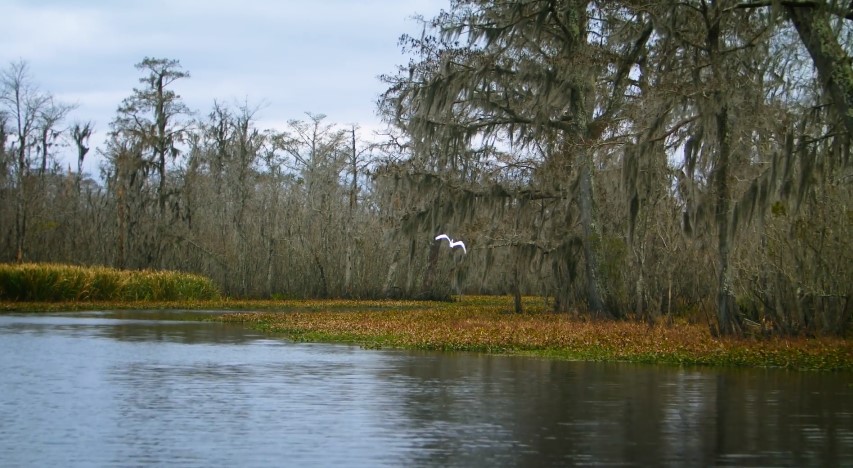After local citizens and organizations, including Louisiana Wildlife Federation, expressed concerns about the potential impacts of a carbon capture and sequestration project in Lake Maurepas, Southeastern Louisiana University (SELU) has been tapped for third-party monitoring in the lake.
According to SELU’s October 2022 announcement, “Southeastern will be monitoring all facets of this project involving the lake to ensure up-to-date data and information are available. We will make all the data we record available to the public to ensure everyone’s right to know any findings,” said Dan McCarthy, dean of the College of Science and Technology.
The carbon capture and sequestration (aka CCS) project is part of Air Products’ Louisiana Clean Energy Complex. The company says that they will “capture 95 percent of the carbon emissions during the production of hydrogen [at its $4.5 billion blue hydrogen manufacturing facility in Ascension Parish], and then permanently store it in a rock formation more than one mile below Lake Maurepas”.
According to the university’s website, the goal of the project is to “conduct a monitoring study in the Lake Maurepas ecosystem, focusing on both the abiotic and biotic components of the lake and surrounding region”. Baseline data will be gathered prior to the sequestration of any carbon beneath Lake Maurepas. Updates will be published on the university’s Lake Maurepas Project website.
The project website notes the following focus areas:
- Gathering real-time data on water quality and atmospheric conditions
- Collecting data on abundance, species richness, diversity, and health of fishes, shrimp, blue crabs, and Rangia clams
- Sampling environmental DNA (eDNA) of fish
- Establishing 12 permanent wetland sites to monitor vegetation growth and changes in canopy cover and monitoring soil salinity, nutrient levels, bulk density, and percent organic matter
- Cypress tree planting (at least 2,000 annually)
- Monitoring physiological stress, ecotoxicological metrics and organismal gas gradients in blue crabs, bullfrogs, catfishes, and alligators
- Monitoring alligator nesting and egg viability in Lake Maurepas WMA
- Analyzing sediment to determine dredging impacts and transport of possible toxic chemicals
This research effort will be helpful to better understand the conditions of Lake Maurepas. SLU has already produced reports on historical impacts on seismic activity, baseline sampling, and its first annual report.
According to SELU’s Phase I Report, seismic activity has had little to no effect on fish or herpetofauna (reptiles and amphibians) assemblages but does note the limited availability of data prior to the first seismic surveys conducted in Lake Maurepas in 1967. The report also mentions that “no swamp data exists from the time of last seismic activity in 1985, but it is inconceivable that said would cause swamp degradation. Approximately 87% of the Maurepas swamp is in varying states of degradation and three factors are roughly equally responsible for the degradation process in Lake Maurepas, namely nutrient limitation, near-permanent flooding, and saltwater intrusion.”
The Phase II Report looked at biotic and abiotic conditions of Lake Maurepas in the context of the Air Products Carbon Sequestration seismic exploration project to gather baseline data prior to carbon sequestration. The biotic data indicate a healthy fish community and consistent physiological conditions in Lake Maurepas vertebrates. For abiotic (water quality) parameters, turbidity showed the most variability but was mainly due to varying wind levels. Other parameters were relatively stable and normal for a typical freshwater system.
The first annual report provides details on monitoring efforts that will be conducted by the SELU aquatics, wetlands, physiology, and chemical monitoring project teams; details on data collection from monitoring buoys; and research, outreach and education support through the Turtle Cove Environmental Field station.
Monitoring buoys were deployed earlier this year. Real-time data will be posted on the SELU project website through the use of easy to interpret dashboards for each buoy. “Each measured parameter has a ‘normal’ range, and the software has the ability to send alert messages if a particular measured parameter is out of the normal range. In essence the buoys will be functioning as an early warning system”, said Director of the Lake Maurepas Monitoring Program Kyle Piller. (Watch video of buoy deployment in Lake Maurepas.)
Resources
- LWF resolution, Support for Carbon Capture to Reduce C02 Emissions but Not Sited in Lake Maurepas
and background paper - Southeastern Louisiana University Lake Maurepas Project Monitoring website
- Southeastern Louisiana University Reports:
- Phase I: Historical Summary of Seismic Impacts on Biotic and Abiotic Conditions of Lake Maurepas
- Phase II: Baseline Sampling in Lake Maurepas (October-December 2022)
- Phase III (Year 1 Annual Report): Lake Maurepas Monitoring (Jan 2023-Dec 2023)
- Air Products Louisiana Clean Energy Complex website
- Air Products project updates page

